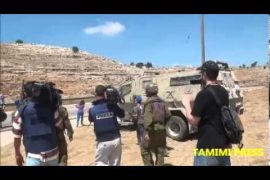1) At the Times of Israel, David Horovitz breaks down what was portrayed by much of the Western media as Hamas’ acceptance of a ceasefire agreement.
“Under the terms that it has set out, therefore, Hamas expects to survive, rearm and reassert full control in Gaza, and establish primacy in the West Bank. Israel will be under attack on multiple fronts. The ambitious, improbable American vision of an Israel integrated into the region, at peace with Saudi Arabia, with a reformed PA ruling in the West Bank Gaza, will be shattered. Most of the hostages will still be held in Gaza, with no prospect of release. And Israel will be more torn and vulnerable than ever.”
2) At the Tablet, Park MacDougald takes a look at ‘The People Setting America on Fire’.
“In fact, it is a mistake both to view the campus protests as a “student” movement and to regard the outsiders as “infiltrators” or somehow separate from the movement. Rather, student activists have been working together with outsiders, with whom they are linked via overlapping activist networks and nationwide organizations. The “student” revolts, in turn, exist on a continuum with the broader anti-Israel protest movement. The campus encampments, for instance, began immediately after the nationwide “economic blockade” on April 15, which saw protesters block the Golden Gate Bridge in San Francisco and “flood” Wall Street in New York City.”
3) At the INSS, Ofir Winter discusses ‘An Opportunity to Repair Israel–Jordan Relations’.
“Since October 7, Jordan has been facing two escalating challenges: First, Iran and its affiliated regional militias are challenging Jordanian sovereignty, as they aim to turn the kingdom’s airspace and territory into a battleground for smuggling weapons and launching attacks against Israel. Second, Islamist forces, both domestic and foreign, are pressuring the kingdom to cancel the peace treaty and normalization with Israel and align with Hamas. The palace’s ability to face both challenges is likely to shape relations between Israel and Jordan as well as the power struggles between pragmatic and radical forces in the Middle East.”
4) Judah Ari Gross reports on a visit to Kiryat Shmona at the eJP.
“In light of these threats and the prospects of even wider conflict, for the past six months, Kiryat Shmona — Israel’s northernmost city — has been a ghost town. Its population of just under 25,000 people has been dispersed throughout the country — with most of the residents spread out among some 230 hotels from the relatively nearby city of Tiberius all the way down to Eilat. According to Stern, roughly 3,000 people, on average, still live in the city, most of them critical workers. The rest, he said, are older people who can’t or won’t leave their homes and people with disabilities who would similarly struggle to pick up and move.”
5) At The Long War Journal, Joe Truzman reports on ‘Syrian fighters belonging to Islamic Jihad killed in southern Lebanon’.
“Islamic Jihad published a statement on its official Telegram channel on Wednesday, grieving the deaths of three fighters belonging to its Syria branch, Ali al-Aswad Brigade. Islamic Jihad said the fighters died in southern Lebanon as a part of the al-Aqsa Flood operation against Israel. […]
The deaths of the Islamic Jihad fighters add to the growing evidence of foreign fighters aligned with the Iran-led Resistance Axis that are actively engaging Israel in the ongoing seven-month conflict.”





